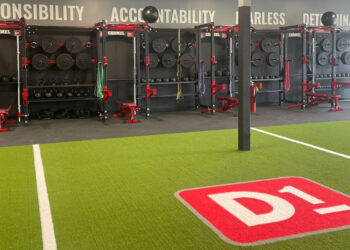 Tony Gray, the vice president of fitness for The Rush Fitness Complex, started his career in the health and fitness industry as a personal trainer. “So, I have always looked at running our business, to some degree, through a trainer’s set of eyes,” said Gray.
Tony Gray, the vice president of fitness for The Rush Fitness Complex, started his career in the health and fitness industry as a personal trainer. “So, I have always looked at running our business, to some degree, through a trainer’s set of eyes,” said Gray.
Although, no longer a “Fit Coach” at The Rush, Gray said personal trainers play an important role in health clubs. “[Personal trainers] get to be the ‘good guys’ that help people do more than they ever imagined possible,” he said. “You get to develop some very special relationships with the member base. I can’t tell you how many great people I have met at ‘my job,’ and what an honor it has been to push, pull and encourage them, to make fitness a part of their lifestyle.”
According to Gray, the relationships that trainers develop with their clients not only benefit the member, but also the club from a business perspective — such as with the “Three Rs”of personal training; revenue, retention and referrals.
Concerning retention, “members that work with a personal trainer tend to keep their membership longer,” said Gray. “These are members that use the club, [and] are getting results — so typically, they are a great source for referrals.” And, of course, the revenue personal trainers bring in from their sessions boost ancillary and dues purchases. At The Rush Fitness Complex, “over 60 percent of our personal training revenue is generated through loyal customers continuing to purchase training packages.”
Jason Stella, the national brand developer for Life Time Fitness, verbally reinforced the idea that personal trainers have significant influence on revenue, retention and referrals. “I do believe that compared to 20 years ago, personal trainers’ roles are completely different,” he said. “The trainers really are responsible for the retention of members.”
 Because of this, Stella takes the advice of his personal trainers to heart — often looking to them for their opinions on new equipment, accessories, programs and training techniques — which are tested at Life Time Fitness’ testing facility in Chanhassen, Minn.
Because of this, Stella takes the advice of his personal trainers to heart — often looking to them for their opinions on new equipment, accessories, programs and training techniques — which are tested at Life Time Fitness’ testing facility in Chanhassen, Minn.
When Life Time Fitness considers distributing a new piece of equipment throughout its clubs across the U.S., Life Time Fitness’ trainers first test the equipment at the testing facility. After testing the equipment, the trainers give the company specific feedback on how the equipment felt, its expected liability and more. “We have a specific process and series of questions dealing with everything from size of equipment, reliability, member or personal training need, to ability to produce revenue in small group classes or increase membership value,” said Stella.
Recently, Life Time Fitness’ personal trainers tested the ReACT (Rapid Eccentric Anaerobic Strength and Core Trainer) Training System, which is a non-impact, anaerobic exercise machine, designed to provide rapid strength gains, core stability and improved balance in just two 10-minute sessions per week. Giving personal trainers the ability to test equipment, such as the ReACT, before its widespread distribution, has provided Life Time Fitness a litmus test as to how the equipment will be received, and used, by trainers and members alike.
Trainer Development
Alice Melesio-Incle, a fitness educator and personal training coach at City Athletic Club in Las Vegas, has worked in the health and fitness industry for over 30 years. During that time, she has trained many up-and-coming personal trainers, and discovered that sometimes, the initial training process for personal trainers just isn’t enough. “While having personal training students shadow me and watch me train my clients, I found that it wasn’t enough for them to learn, since they still needed hands-on training,” explained Melesio-Incle.
 Melesio-Incle created a two-part internship program. In the first program, called “Hands-on Training,” trainers with little to no hands-on experience with members, go through an extensive workshop to learn the basics of personal training.
Melesio-Incle created a two-part internship program. In the first program, called “Hands-on Training,” trainers with little to no hands-on experience with members, go through an extensive workshop to learn the basics of personal training.
In the accelerated program, “Project Interns” — trainers who already have garnered some experience — can skip the hands-on training, and begin working with clients at a discounted fee. “For the benefit of training at such a low price, these members get trained by the learning interns,” explained Melesio-Incle. “During the time that the interns are training the clients, they are being supervised by myself.”
According to Melesio-Incle, the programs are a three-fold win for any health club. “The clients get to train at an economical rate, and the learning interns get hands-on, client-training experience of various fitness levels and ages,” she said. The trainer is able to showcase their skills to a client, which might want to sign up with them at a later date. “Not only does the gym benefit financially, but the gym is acquiring quality and professional trainers.”
City Athletic Club, a personal training-focused facility in Las Vegas, Nev., recognized a need for Melesio-Incle’s internship programs. The club uses her internship programs to train many of its potential personal trainers.
According to Lawrence Pinson, the personal training manager at City Athletic Club, it is his goal as the personal training manager to continually develop and cultivate his personal trainers’ careers and skills. “We have personal trainers from all walks of life,” said Pinson. “It’s interesting to see the trainers as they develop and grow. We show them how to market themselves, we help them with business cards, etc. My ultimate goal is to help them run their own business.”
Stella stressed the importance of personal training directors helping their personal trainers, instead of being passive managers. “Personal training directors have to be able to coach their trainers on the aspects of selling.”
According to Stella, the key to helping trainers develop and grow lies in teaching trainers how to sell their services. “If you feel like you’re selling, you’re doing it wrong,” he said. “It’s not about selling. It’s about offering a service and a solution. It’s more of a buying process. The member should purchase something from you, versus you selling something to them.” Stella said relationship-based selling is how trainers can accomplish this. “Walk the floor with the purpose to help people, not just sell them.”
To further discover the key to successful selling, Stella conducted a study, which analyzed 100 of the top trainers in the industry, to discover their keys to success. He discovered that the most successful trainers shared seven attributes — and one of those attributes included a personal mission statement. “Every one of the top trainers had some form of a personal mission statement,” said Stella. “They had a purpose and lived by that purpose.”
To aid its personal trainers in selling personal training packages, The Rush Fitness Complex uses its sales team to aid its personal trainers in selling. “Our membership consultants are trained to sell fitness-based memberships (memberships that include personal training),” explained Gray. “We enforce this because we believe it is the best option to ensure our members get the best possible results.”
“I know this sounds cliché, but our FC’s (fitness coaches) take a tremendous amount of pride in helping people achieve their goals and beyond,” added Gray. “We recruit fitness coaches primarily based on having a great personality; we know we can teach them the rest.”
By Rachel Zabonick
Stay ahead in the fitness industry with exclusive updates!
Rachel Zabonick-Chonko is the editor-in-chief of Club Solutions Magazine. She can be reached at rachel@peakemedia.com.











